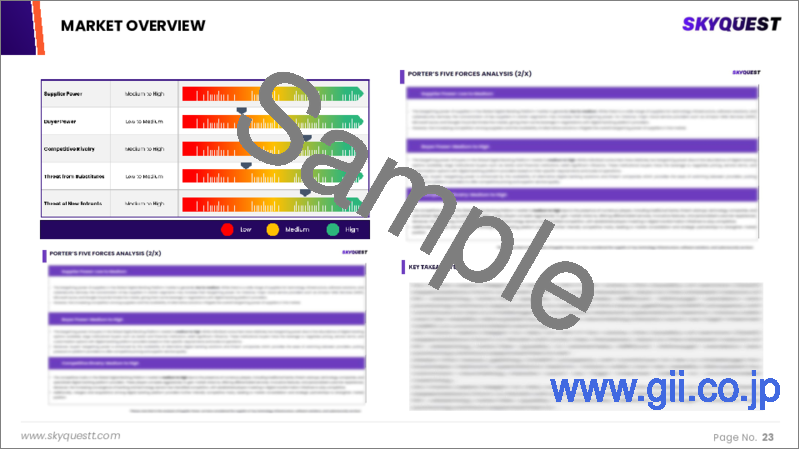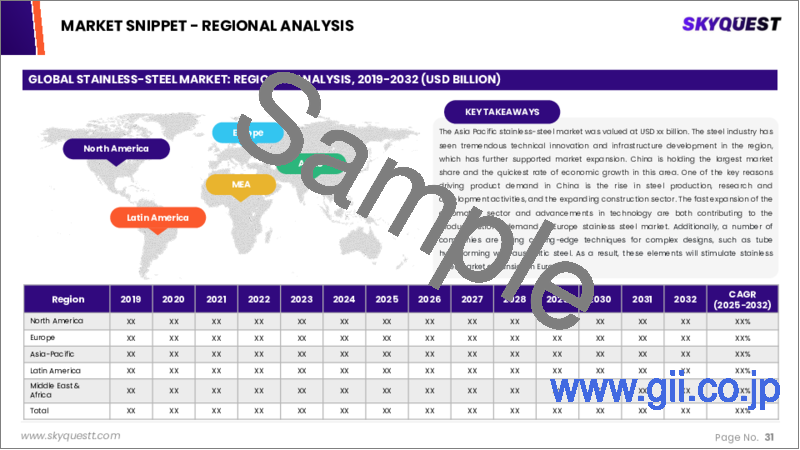|
|
市場調査レポート
商品コード
1610789
ステンレス鋼の市場規模、シェア、成長分析、グレード別、製品別、用途別、地域別 - 産業予測、2024年~2031年Stainless Steel Market Size, Share, Growth Analysis, By Grade (200 Series, 300 Series), By Product (Flat, Long), By Application, By Region - Industry Forecast 2024-2031 |
||||||
|
|||||||
| ステンレス鋼の市場規模、シェア、成長分析、グレード別、製品別、用途別、地域別 - 産業予測、2024年~2031年 |
|
出版日: 2024年12月11日
発行: SkyQuest
ページ情報: 英文 157 Pages
納期: 3~5営業日
|
全表示
- 概要
- 目次
ステンレス鋼の世界市場規模は、2022年に1,126億米ドルと評価され、2023年の1,206億米ドルから2031年には2,035億5,000万米ドルに成長し、予測期間中(2024-2031年)のCAGRは6.8%で成長する見通しです。
ステンレス鋼市場は、自動車、建設、エレクトロニクスなど様々な産業における旺盛な需要に牽引され、大きく成長する見通しです。自動車分野の拡大、インフラや住宅開発への投資の増加がこの需要を促進する主な要因となっています。ステンレス鋼は、耐食性、強度、美観、低メンテナンスコストなどの長所から、建設、輸送、工業プロセスなどの用途において、炭素鋼よりも優れた選択肢として位置づけられています。さらに、家電製品や調理器具のような消費財での使用は、市場機会をさらに押し上げます。2019年はパンデミックが課題となり、プロジェクトの遅延や需要の減少による減速につながったが、経済の回復がステンレス鋼市場を再活性化し、今後の望ましい成長率を牽引すると予想されます。
目次
イントロダクション
- 調査の目的
- 調査範囲
- 定義
調査手法
- 情報調達
- 二次データと一次データの方法
- 市場規模予測
- 市場の前提条件と制限
エグゼクティブサマリー
- 世界市場の見通し
- 供給と需要の動向分析
- セグメント別機会分析
市場力学と見通し
- 市場概要
- 市場規模
- 市場力学
- 促進要因と機会
- 抑制要因と課題
- ポーター分析と影響
- 競争企業間の敵対関係
- 代替品の脅威
- 買い手の交渉力
- 新規参入業者の脅威
- 供給企業の交渉力
主な市場の考察
- 重要成功要因
- 競合の程度
- 主な投資機会
- 市場エコシステム
- 市場の魅力指数(2023年)
- PESTEL分析
- マクロ経済指標
- バリューチェーン分析
- 価格分析
- 技術の進歩
- 規制情勢
- ケーススタディ
- 顧客と購買基準の分析
ステンレス鋼市場規模:グレード別& CAGR(2024-2031)
- 市場概要
- 200シリーズ
- 300シリーズ
- 400シリーズ
- デュプレックスシリーズ
- その他
ステンレス鋼市場規模:製品別& CAGR(2024-2031)
- 市場概要
- フラット
- ロング
ステンレス鋼市場規模:用途別& CAGR(2024-2031)
- 市場概要
- 建築・建設
- 自動車・輸送
- 消費財
- 機械工学・重工業
- 電子機器
- 食品製造
- その他
ステンレス鋼市場規模& CAGR(2024-2031)
- 北米
- 米国
- カナダ
- 欧州
- 英国
- ドイツ
- スペイン
- フランス
- イタリア
- その他欧州地域
- アジア太平洋地域
- 中国
- インド
- 日本
- 韓国
- その他アジア太平洋地域
- ラテンアメリカ
- ブラジル
- その他ラテンアメリカ地域
- 中東・アフリカ
- GCC諸国
- 南アフリカ
- その他中東・アフリカ
競合情報
- 上位5社の比較
- 主要企業の市場ポジショニング(2023年)
- 主な市場企業が採用した戦略
- 市場の最近の動向
- 企業の市場シェア分析(2023年)
- 主要企業の企業プロファイル
- 会社概要
- 製品ポートフォリオ分析
- セグメント別シェア分析
- 収益の前年比比較(2021-2023)
主要企業プロファイル
- Outokumpu
- POSCO
- Acerinox
- Jindal Stainless
- Aperam
- Thyssenkrupp
- Nippon Steel Corporation
- Sandvik AB
- Carpenter Technology Corporation
- Guangxi Beibu Gulf International Port Group
- Allegheny Technologies Incorporated
- Jiangsu Shagang Group
- Nisshin Steel Co. Ltd.
- North American Stainless
- Bristol Metals, LLC
- Ulbrich Stainless Steels & Special Metals, Inc.
結論と推奨事項
Global Stainless Steel Market size was valued at USD 112.6 billion in 2022 and is poised to grow from USD 120.6 billion in 2023 to USD 203.55 billion by 2031, growing at a CAGR of 6.8% during the forecast period (2024-2031).
The stainless steel market is poised for significant growth, driven by robust demand across various industries such as automotive, construction, and electronics. The expansion of the automotive sector and increased investments in infrastructure and residential development are key factors propelling this demand. Stainless steel's advantages- including corrosion resistance, strength, aesthetic appeal, and low maintenance costs-position it as a superior choice over carbon steel for applications in construction, transportation, and industrial processes. Additionally, its use in consumer goods like appliances and cookware further boosts market opportunities. While the pandemic posed challenges in 2019, leading to slowdowns due to project delays and decreased demand, the recovery of the economy is expected to reinvigorate the stainless steel market, driving desirable growth rates moving forward.
Top-down and bottom-up approaches were used to estimate and validate the size of the Global Stainless Steel market and to estimate the size of various other dependent submarkets. The research methodology used to estimate the market size includes the following details: The key players in the market were identified through secondary research, and their market shares in the respective regions were determined through primary and secondary research. This entire procedure includes the study of the annual and financial reports of the top market players and extensive interviews for key insights from industry leaders such as CEOs, VPs, directors, and marketing executives. All percentage shares split, and breakdowns were determined using secondary sources and verified through Primary sources. All possible parameters that affect the markets covered in this research study have been accounted for, viewed in extensive detail, verified through primary research, and analyzed to get the final quantitative and qualitative data.
Global Stainless Steel Market Segmental Analysis
Global Stainless Steel Market is segmented by Grade, Product, Application, and Region. Based on Grade, the market is segmented into 200 Series, 300 Series, 400 Series, Duplex Series, and Others. Based on Product, the market is segmented into Flat, and Long. Based on Application, the market is segmented into Building & Construction, Automotive & Transportation, Consumer Goods, Mechanical Engineering & Heavy Industries, Electronic Appliances, Food Manufacturing, and Others. Based on Region, the market is segmented into North America, Europe, Asia Pacific, Latin America and Middle East & Africa.
Driver of the Global Stainless Steel Market
The rapid advancement of the automotive industry is significantly fueling the growth of the global stainless steel market. Due to its corrosion resistance, high strength, and heat tolerance, stainless steel is an ideal material for numerous automotive components such as hose clamps and seatbelt springs. The World Steel Organization anticipates an increasing application of stainless steel in essential elements like catalytic converters, fuel tanks, chassis, bodywork, and suspension systems. Furthermore, emerging innovations in electric vehicles and technological advancements in the automotive sector will enhance the material's adoption. Consequently, the rising demand from automakers is poised to accelerate the stainless steel market's expansion.
Restraints in the Global Stainless Steel Market
The global stainless steel market faces significant restraints due to the availability of alternative materials such as aluminum and carbon steel, which can hinder market growth. These substitutes appeal to consumers as they often weigh less and are more water-resistant compared to stainless steel. Consequently, the heavy nature of stainless steel limits its application in sectors where lightweight materials are essential, such as in consumer products, engineering, and electronics. This competitive landscape, combined with the limitations of stainless steel, results in slower adoption rates and poses challenges for the overall expansion of the stainless steel market across various industries.
Market Trends of the Global Stainless Steel Market
The global stainless steel market is poised for significant expansion, driven primarily by rising consumption in the construction sector. Historically, the high cost of stainless steel limited its application in structural projects; however, advancements in technology over the past decade have increased its affordability and improved properties, such as corrosion resistance and durability. These developments have catalyzed a shift in builder preferences, favoring stainless steel for its long-term performance benefits. As urbanization accelerates and infrastructure demands grow, the stainless steel market is likely to see lucrative opportunities across various applications, reinforcing its position as a pivotal material in modern construction.
Table of Contents
Introduction
- Objectives of the Study
- Scope of the Report
- Definitions
Research Methodology
- Information Procurement
- Secondary & Primary Data Methods
- Market Size Estimation
- Market Assumptions & Limitations
Executive Summary
- Global Market Outlook
- Supply & Demand Trend Analysis
- Segmental Opportunity Analysis
Market Dynamics & Outlook
- Market Overview
- Market Size
- Market Dynamics
- Driver & Opportunities
- Restraints & Challenges
- Porters Analysis & Impact
- Competitive rivalry
- Threat of substitute
- Bargaining power of buyers
- Threat of new entrants
- Bargaining power of suppliers
Key Market Insights
- Key Success Factors
- Degree of Competition
- Top Investment Pockets
- Market Ecosystem
- Market Attractiveness Index, 2023
- PESTEL Analysis
- Macro-Economic Indicators
- Value Chain Analysis
- Pricing Analysis
- Technological Advancement
- Regulatory Landscape
- Case Studies
- Customer & Buying Criteria Analysis
Global Stainless Steel Market Size by Grade & CAGR (2024-2031)
- Market Overview
- 200 Series
- 300 Series
- 400 Series
- Duplex Series
- Others
Global Stainless Steel Market Size by Product & CAGR (2024-2031)
- Market Overview
- Flat
- Long
Global Stainless Steel Market Size by Application & CAGR (2024-2031)
- Market Overview
- Building & Construction
- Automotive & Transportation
- Consumer Goods
- Mechanical Engineering & Heavy Industries
- Electronic Appliances
- Food Manufacturing
- Others
Global Stainless Steel Market Size & CAGR (2024-2031)
- North America, (Grade, Product, Application)
- US
- Canada
- Europe, (Grade, Product, Application)
- UK
- Germany
- Spain
- France
- Italy
- Rest of Europe
- Asia-Pacific, (Grade, Product, Application)
- China
- India
- Japan
- South Korea
- Rest of Asia Pacific
- Latin America, (Grade, Product, Application)
- Brazil
- Rest of Latin America
- Middle East & Africa, (Grade, Product, Application)
- GCC Countries
- South Africa
- Rest of Middle East & Africa
Competitive Intelligence
- Top 5 Player Comparison
- Market Positioning of Key Players, 2023
- Strategies Adopted by Key Market Players
- Recent Developments in the Market
- Company Market Share Analysis, 2023
- Company Profiles of All Key Players
- Company Details
- Product Portfolio Analysis
- Company's Segmental Share Analysis
- Revenue Y-O-Y Comparison (2021-2023)
Key Company Profiles
- Outokumpu
- Company Overview
- Business Segment Overview
- Financial Updates
- Key Developments
- POSCO
- Company Overview
- Business Segment Overview
- Financial Updates
- Key Developments
- Acerinox
- Company Overview
- Business Segment Overview
- Financial Updates
- Key Developments
- Jindal Stainless
- Company Overview
- Business Segment Overview
- Financial Updates
- Key Developments
- Aperam
- Company Overview
- Business Segment Overview
- Financial Updates
- Key Developments
- Thyssenkrupp
- Company Overview
- Business Segment Overview
- Financial Updates
- Key Developments
- Nippon Steel Corporation
- Company Overview
- Business Segment Overview
- Financial Updates
- Key Developments
- Sandvik AB
- Company Overview
- Business Segment Overview
- Financial Updates
- Key Developments
- Carpenter Technology Corporation
- Company Overview
- Business Segment Overview
- Financial Updates
- Key Developments
- Guangxi Beibu Gulf International Port Group
- Company Overview
- Business Segment Overview
- Financial Updates
- Key Developments
- Allegheny Technologies Incorporated
- Company Overview
- Business Segment Overview
- Financial Updates
- Key Developments
- Jiangsu Shagang Group
- Company Overview
- Business Segment Overview
- Financial Updates
- Key Developments
- Nisshin Steel Co. Ltd.
- Company Overview
- Business Segment Overview
- Financial Updates
- Key Developments
- North American Stainless
- Company Overview
- Business Segment Overview
- Financial Updates
- Key Developments
- Bristol Metals, LLC
- Company Overview
- Business Segment Overview
- Financial Updates
- Key Developments
- Ulbrich Stainless Steels & Special Metals, Inc.
- Company Overview
- Business Segment Overview
- Financial Updates
- Key Developments





